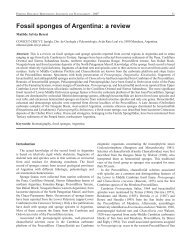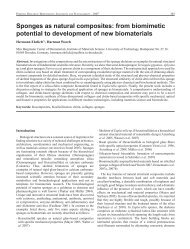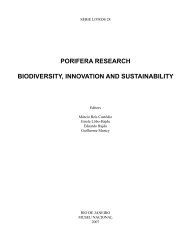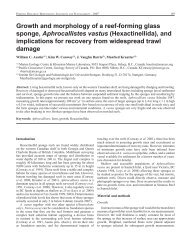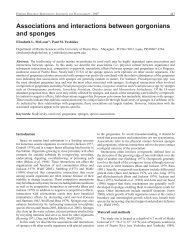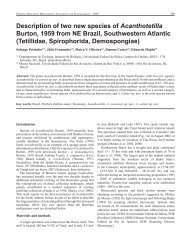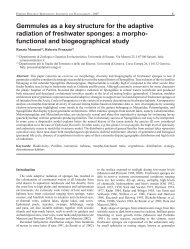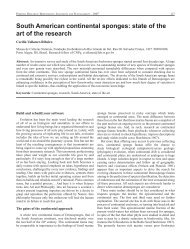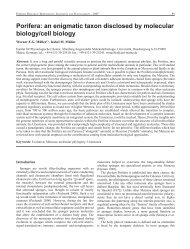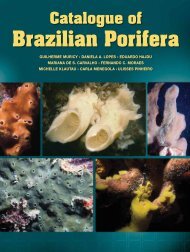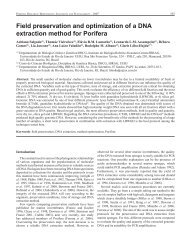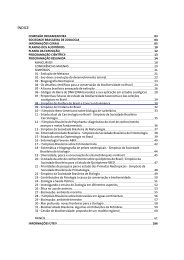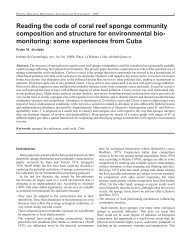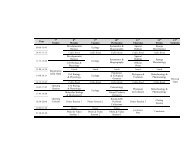Symbiotic relationships between sponges and other ... - Porifera Brasil
Symbiotic relationships between sponges and other ... - Porifera Brasil
Symbiotic relationships between sponges and other ... - Porifera Brasil
Create successful ePaper yourself
Turn your PDF publications into a flip-book with our unique Google optimized e-Paper software.
<strong>Porifera</strong> research: Biodiversity, innovation <strong>and</strong> sustainaBility - 2007<br />
<strong>Symbiotic</strong> <strong>relationships</strong> <strong>between</strong> <strong>sponges</strong> <strong>and</strong> <strong>other</strong><br />
organisms from the Sea of Cortes (Mexican Pacific<br />
coast): same problems, same solutions<br />
Enrique Ávila (1,2*) , José Luís Carballo (1) , José Antonio Cruz-Barraza (1,2)<br />
(1) Laboratorio de Ecología del Bentos, Instituto de Ciencias del Mar y Limnología. Universidad Nacional Autónoma de<br />
México, Estación Mazatlán, Avenida Joel Montes Camarena S/N, Apartado Postal 811, Mazatlán 82000, México. Tel.<br />
+52 669 985 28 45. Fax: +52 669 982 61 33. kike@ola.icmyl.unam.mx<br />
(2) Posgrado en Ciencias del Mar y Limnología, UNAM, Mazatlán, México<br />
Abstract: This study provides a morphological description of three symbiotic associations <strong>between</strong> <strong>sponges</strong> (Haplosclerida)<br />
<strong>and</strong> <strong>other</strong> macroorganisms from the Sea of Cortes (Mexican Pacific Ocean). These associations include: (1) a two-sponge<br />
association (Haliclona sonorensis/Geodia media), (2) a sponge-red macroalga association (Haliclona caerulea/Jania adherens)<br />
<strong>and</strong> (3), a sponge-coral association (Chalinula nematifera/Pocillopora spp.). So far these interactions seem to be obligatory<br />
for the <strong>sponges</strong> (Haliclona spp. <strong>and</strong> C. nematifera), since we have never found them living in isolation. Interestingly, similar<br />
associations have been described from <strong>other</strong> places around the world. Associations quite similar to (1) have been described<br />
from the Caribbean, <strong>and</strong> associations (2) <strong>and</strong> (3) are comparable to <strong>other</strong>s described from the Western Pacific. Instead of<br />
comparing these associations with their “sibling” associations worldwide, we discussed the ability of haplosclerid <strong>sponges</strong><br />
to form symbiotic associations with <strong>other</strong> organisms, since these <strong>sponges</strong> pertain to the group of which the most associations<br />
have been described.<br />
Keywords: Sea of Cortes, sponge-alga, sponge-coral, symbiotic associations, two-sponge<br />
Introduction<br />
Sponges are one of the major phyla found in the hardsubstrate<br />
marine benthos (Sarà <strong>and</strong> Vacelet 1973). One of their<br />
more interesting characteristics is that they are able to establish<br />
a great diversity of <strong>relationships</strong> (mutualism, commensalism<br />
<strong>and</strong> parasitism) with unicellular <strong>and</strong> multicellular organisms<br />
(Palumbi 1985, Rützler 1990, Magnino <strong>and</strong> Gaino 1998, Ilan<br />
et al. 1999, Wulff 1999, Thakur <strong>and</strong> Müller 2004).<br />
Most of these <strong>relationships</strong> have been reported in the<br />
Caribbean (West 1979, Rützler 1990, Wulff 1997a, 1997b,<br />
1999, Wilcox et al. 2002), Mediterranean Sea (Uriz et al.<br />
1992, Gaino <strong>and</strong> Sará 1994), Red Sea (Meroz <strong>and</strong> Ilan 1995,<br />
Ilan et al. 1999), Indo-Pacific region (Steindler et al. 2002,<br />
Calcinai et al. 2004) <strong>and</strong> Western Pacific (Vacelet 1981,<br />
Trautman et al. 2000). Surprisingly, in a large number of<br />
cases, the same species are involved in similar interactions in<br />
different oceans (Ilan et al. 1999, Wulff 2006). For example,<br />
the <strong>sponges</strong> Haliclona caerulea Hechtel, 1965, Haliclona<br />
cymaeformis Esper, 1794 <strong>and</strong> Dysidea janiae (Duchassaing<br />
<strong>and</strong> Michelotti, 1864) are species found to establish similar<br />
interactions with red macroalgae (Vacelet 1981, Rützler 1990,<br />
Trautman et al. 2000, Carballo <strong>and</strong> Ávila 2004). However, it is<br />
unknown whether this group of “cosmopolitan” associations<br />
occurs in the East Pacific Ocean.<br />
147<br />
The order Haplosclerida (Demospongiae) is the group<br />
in which the most of the symbiotic <strong>relationships</strong> have been<br />
registered with the family Chalinidae Gray, 1867 accounting<br />
for more than 50% of the associations described in this<br />
order (see discussion). Sponges of this order can establish<br />
associations with microorganisms such as bacteria (Vacelet et<br />
al. 2001), cyanobacteria (Steindler et al. 2002), dinoflagellates<br />
(Garson et al. 1998) <strong>and</strong> zoochlorellae (Frost <strong>and</strong> Williamson<br />
1980), <strong>and</strong> with macroorganisms such as polychaetes (Dauer<br />
1974), macroalgae (Vacelet 1981), mangroves (Ellison et al.<br />
1996), barnacles (Ilan et al. 1999), hydrozoans (Schuchert<br />
2003), anthozoans (West 1979), ophiurids (Henkel <strong>and</strong><br />
Pawlik 2005), insects (Gaino et al. 2004) <strong>and</strong> <strong>other</strong> <strong>sponges</strong><br />
(Wilcox et al. 2002).<br />
In the present study, we describe three interactions involving<br />
haplosclerid <strong>sponges</strong> from the Sea of Cortes (Mexican Pacific<br />
Ocean). They are a two-sponge association (Haliclona<br />
sonorensis-Geodia media), a sponge-alga association<br />
(Haliclona caerulea-Jania adherens) <strong>and</strong> a sponge-coral<br />
association (Chalinula nematifera-Pocillopora spp.). We<br />
discuss the surprising parallelism that exists worldwide,<br />
given that very similar interactions occur in different oceans.<br />
In addition, we comment on the characteristics that this group<br />
– in which more symbiotic <strong>relationships</strong> have been registered –<br />
has in order to establish these symbiotic associations.
148<br />
Material <strong>and</strong> methods<br />
Specimens of the three associations were collected by<br />
SCUBA diving from 2 to 12 m depth, in four localities from<br />
the Sea of Cortes (Eastern Pacific Ocean, Mexico) (Fig. 1).<br />
We followed the techniques described by Rützler (1974) for<br />
spicule <strong>and</strong> tissue preparations for light microscopy. Crosssections<br />
of the specimens were washed in distilled water<br />
<strong>and</strong> then dried on a cover glass <strong>and</strong> coated with gold for<br />
scanning electron microscope (SEM) observations. A number<br />
of 20 to 50 spicules chosen r<strong>and</strong>omly were measured (length<br />
x width) from each of the specimens studied. The number<br />
<strong>between</strong> brackets in each description is the average. After<br />
the description, the specimens were fixed in formaldehyde<br />
4% <strong>and</strong> after 24 h they were transferred to 70% alcohol for<br />
their preservation. All the specimens were deposited in the<br />
Colección de Esponjas of the Instituto de Ciencias del Mar<br />
y Limnología, UNAM (LEB-ICML-UNAM), in Mazatlán<br />
(Mexico).<br />
In the Haliclona sonorensis/Geodia media association, the<br />
surface of G. media covered by H. sonorensis was estimated.<br />
First we took photographs of the specimens, then we<br />
determined the covered area (%) using the computer program<br />
Coral Point Count with Excel extensions (CPCe) (Kohler <strong>and</strong><br />
Gill 2006). The frequency of the C. nematifera/Pocillopora<br />
spp. association was determined in three transects of 50 m<br />
length at a depth <strong>between</strong> 4 to 6 m. In each one of these<br />
transects we chose 20 colonies of coral at r<strong>and</strong>om, <strong>and</strong><br />
determined the percentage of these containing sponge. In<br />
the same area, we also checked if the sponge was on an<strong>other</strong><br />
type of substratum. For each sample of the association we<br />
determined the species of coral <strong>and</strong> estimated the percentage<br />
of the colony overgrown by the sponge as number of branches<br />
with sponge of the total of branches.<br />
Results<br />
Association Haliclona sonorensis Cruz-Barraza <strong>and</strong><br />
Carballo, 2006 – Geodia media Bowerbank, 1873<br />
Material examined. Eleven specimens of the association<br />
were collected <strong>between</strong> 2 <strong>and</strong> 5 m depth in two localities<br />
from the northern Sea of Cortes: Punta Cazón (Bahía Kino,<br />
Sonora, 28°52’20” N, 112°02’01” W), <strong>and</strong> Punta Pinta (La<br />
Choya, Puerto Peñasco, Sonora, 31°18’05” N, 113°59’11”<br />
W) (Fig. 1), from August 2000 to April 2005.<br />
Description of the species involved in the association. The<br />
epizoic sponge was identified as Haliclona sonorensis Cruz-<br />
Barraza <strong>and</strong> Carballo, 2006, which is a cushion-shaped sponge<br />
from 2 to 5 mm in thickness (Fig. 2A). Consistency is soft,<br />
compressible, but fragile <strong>and</strong> brittle. The surface is smooth<br />
<strong>and</strong> the ectosomic layer is not easily detachable. The color is<br />
pinkish violet in life <strong>and</strong> ocre or light brown in alcohol. The<br />
oscules are scarce, <strong>and</strong> circular or oval-shaped (from 0.5 to 1<br />
mm in diameter), situated at the summits of volcano-shaped<br />
elevations. The skeletal material is constituted by oxeas that<br />
measure: 77-(112)-150 x 2-(5.6)-10 µm.<br />
The supporting sponge was identified as Geodia media<br />
Bowerbank, 1873. This is a massive-incrusting to massive<br />
amorphous sponge (from 3.5 to 8 cm thick). The surface is<br />
irregular, smooth to the naked eye, but finely rough to the<br />
touch. The natural color of the surface is from dark-brown to<br />
white. The choanosome is yellowish or beige. Small ostialpores<br />
from 150 to 300 µm are regularly distributed on the<br />
surface. The oscules are contained in several small, circular<br />
or oval-shaped well-defined flattened sieves (containing<br />
from 7 to more than 100 oscules). The oscules measure from<br />
0.22 to 2.5 mm in diameter. Consistency of the ectosome is<br />
very hard due to the cortex of sterrasters. The choanosome<br />
is cavernous <strong>and</strong> very densely spiculated, with a firm <strong>and</strong><br />
slightly compressible consistency. The skeletal material is<br />
constituted by megascleres: oxeas, 620-(1430)-1950 x 10-<br />
(31)-42 µm; large styles, 620-(1077)-1260 x 22-(36)-45<br />
µm; strongyloxeas, 150-(197.2)-292 x 2.5-(4.9)-7.5 µm;<br />
plagiotriaenes, 550-(1078)-1700 µm rabdome length; <strong>and</strong><br />
anatriaenes, 1120-(1410)-2040 µm rabdome length, <strong>and</strong><br />
microscleres: sterrasters, 25-(62.8)-90 µm oxyasters, 20-<br />
(27.2)-45 µm; oxyspherasters, 6.3-(9.5)-13 µm.<br />
Description of the association. The specimens of the<br />
association were found attached to the rocky substrata,<br />
covering areas from 8 x 6.5 to 20 x 15 cm, approximately.<br />
H. sonorensis forms a thin layer that covers up to 57 % of<br />
the surface of G. media, while the surface that is not covered<br />
by the sponge is occupied by <strong>other</strong> epibionts (green <strong>and</strong> red<br />
algae, bryozoans, polychaetes <strong>and</strong> bivalves). Only the oscular<br />
areas (from 1 to 4 cm in diameter) are free of these epibionts<br />
(Fig. 2A). In some cases, more than one individual of H.<br />
sonorensis was observed on a same specimen of Geodia, which<br />
was evident by their different tonality of coloration. Despite<br />
being interwoven, Haliclona was unattached in some areas,<br />
where we observed that the external tissue of Geodia did not<br />
seem to be damaged by the epizoic sponge (Fig. 2B, C). The<br />
area of G. media lacking epibionts has a rough texture due<br />
to the external layer of sterrasters (Fig. 2C, D), but the SEM<br />
showed that the megascleres (triaenes <strong>and</strong> oxeas) of G. media<br />
protrude the surface in the areas covered by Haliclona (Fig.<br />
2C, F) penetrating in the Haliclona sonorensis tissue (Fig.<br />
2D, E). There were spicules (oxeas) of H. sonorensis inside<br />
the ostias <strong>and</strong> embedded in the choanosome of G. media, <strong>and</strong><br />
there were also sterrasters of G. media in the choanosome of<br />
H. sonorensis.<br />
Haliclona sonorensis has been invariably found living on<br />
the surface of G. media which suggests that this species needs<br />
to live in association with G. media.<br />
Association Chalinula nematifera (de Laubenfels, 1954)<br />
– Pocillopora spp. Lamarck, 1816<br />
Material examined. A total of ten specimens of this<br />
association were collected <strong>between</strong> 3 <strong>and</strong> 12 m depth in<br />
three sites from Isabel Isl<strong>and</strong> (Bahía Tiburones, Playa Las<br />
Monas <strong>and</strong> Playa Iguanas), Nayarit, Mexico (28°52’20” N,<br />
112°02’01” W) (Fig. 1), from December 2003 to July 2006.<br />
Morphological description of the species in the association.<br />
The epizootic sponge has been identified as Chalinula<br />
nematifera (de Laubenfels, 1954). This is an encrusting<br />
sponge of violet color (1-4 mm thickness). This sponge grows<br />
only on live corals found in Isabel Isl<strong>and</strong> (Fig. 3). The surface<br />
is smooth to the naked eye, but it is punctated <strong>and</strong> shaggy in<br />
some places. Oscules are abundant, circular, from 4 to 6 mm
Fig. 1: Sampling localities<br />
(letters). The numbers indicate<br />
the site where specimens of each<br />
sponge association were collected:<br />
(1) two-sponge association, (2)<br />
sponge-alga association <strong>and</strong> (3)<br />
sponge-coral association.<br />
in diameter, <strong>and</strong> regularly distributed on the surface. They<br />
are situated at the summits of volcano-shaped elevations.<br />
Consistency is soft <strong>and</strong> spongy, somewhat elastic <strong>and</strong> slimy.<br />
The skeleton consists of oxeas: 87-(98)-112.5 x 2.5-(4.4)-5<br />
µm. Our specimens also show the characteristic pale threads<br />
through the body as described by de Laubenfels (1954),<br />
which presumably is a symbiotic fungus (WF Prud’homme<br />
van Reine, comments in de Weerdt 2002).<br />
The coral species on which C. nematifera was found<br />
were identified as Pocillopora damicornis Linnaeus, 1758,<br />
P. me<strong>and</strong>rina Dana, 1846, P. capitata Verrill, 1864 <strong>and</strong> P.<br />
verrucosa Ellis <strong>and</strong> Sol<strong>and</strong>er, 1786. In general, these coral<br />
species have characteristic shape because they form densely<br />
ramified colonies. They have calices crowded together over<br />
regularly-spaced wart-like projections (verrucae) (P. capitata<br />
<strong>and</strong> P. verrucosa).<br />
Description of the association. C. nematifera was found<br />
always on live ramified corals that live in areas exposed to<br />
light, most frequently with P. verrucosa (67%), <strong>and</strong> never on<br />
an<strong>other</strong> type of substratum. Nevertheless, it is possible to find<br />
these species of coral (mentioned above) without the sponge.<br />
149<br />
Approximately 17% of the Pocillopora colonies studied<br />
had C. nematifera in association. In these sponge/coral<br />
interactions, C. nematifera can cover branches partially or<br />
totally (5±5.12% of the total of branches of the colony), <strong>and</strong><br />
in all these cases we observed that the surface of the covered<br />
coral has no polyps. This sponge adhered firmly to the coral<br />
<strong>and</strong> is not easy to detach it from the substratum without<br />
breaking it. In fact, through the SEM images, we observed<br />
that the skeletal structure of the sponge seems to be cemented<br />
to the coral septa by spongin layers (Fig. 3C).<br />
Association Haliclona caerulea Hechtel, 1965 – Jania<br />
adherens Lamouroux, 1816<br />
Material examined. Sixteen specimens of the sponge-alga<br />
association were collected from ten sites from the Mazatlán<br />
Bay (23º13’49’’ N, 106º27’43’’ W), Sinaloa, Mexico (Fig. 1),<br />
<strong>between</strong> 2 to 6 m depth, from November 1997 until October<br />
2003.<br />
Morphological description of the species in the association.<br />
Haliclona (Gellius) caerulea is a massive sponge (from
150<br />
Fig. 2: Haliclona sonorensis<br />
– Geodia media association. A.<br />
two-sponge association containing<br />
several epibionts on its surface<br />
except on the osculate area.<br />
B. cross section of a specimen<br />
showing the Geodia surface almost<br />
totally covered by Haliclona<br />
sonorensis. D. SEM image<br />
showing the surface contact of the<br />
two interacting <strong>sponges</strong>, <strong>and</strong> C,<br />
E, F. the megascleres of Geodia<br />
protruding its ectosome, which are<br />
used as anchorage for the external<br />
sponge. The arrow in F shows<br />
an ostium of the internal sponge.<br />
Scale bars: A <strong>and</strong> B= 2 cm, C= 5<br />
mm, D= 500 µm, E= 200 µm, F=<br />
500 µm.<br />
3 to 13 cm high), white or beige in life <strong>and</strong> very brittle. The<br />
skeleton is constituted by oxeas (82.5-(177.3)-210 µm) <strong>and</strong><br />
sigmas (17.5-(21.6)-30 µm). The sponge has an unispicular<br />
ectosomal skeleton, formed by an isotropic tangential reticulation<br />
of oxeas, <strong>and</strong> the choanosomal skeleton is a somewhat<br />
confused reticulation of uni-multispicular primary <strong>and</strong> secondary<br />
lines that are difficult to appreciate because of their<br />
association with the alga (Fig. 4B).<br />
The alga was identified as Jania adherens Lamouroux,<br />
1816, which is an articulated erect red macroalga. The alga is<br />
pink with white joints, repeatedly branched, with a calcified<br />
thallus (from 0.4 to 0.5 mm diameter) except at the genicula.<br />
Description of the association. This sponge lives in intimate<br />
association with the red calcareous alga Jania adherens. The<br />
association consists of a massive <strong>and</strong> compact form where the<br />
sponge completely fills the spaces <strong>between</strong> the algal branches<br />
(Fig. 4A). The sponge generally covers the alga, <strong>and</strong> the algal<br />
branches very rarely protrude beyond the association surface.<br />
The morphology of the association is derived from the growth<br />
form of both organisms. Specimens of this association are lo-
Fig. 3: A. Chalinula nematifera –<br />
Pocillopora spp. association. B. C.<br />
nematifera tissue in close contact<br />
with the coral polyps (arrows). C.<br />
SEM image showing the skeletal<br />
structure of the sponge cemented<br />
to the coral septae (arrows). Scale<br />
bars A= 1 cm, B= 2000 µm, C =<br />
100 µm.<br />
cally abundant in rocky substrate environments (2-6 m depth),<br />
in areas of strong wave force. However, in these places, it is<br />
not possible to find the two species living in isolation, even<br />
though J. adherens lives in isolation in the intertidal zone.<br />
Jania adherens forms compact turfs approximately 2 cm high<br />
in the intertidal zone. However, in the subtidal zone (in association<br />
with H. caerulea) it reaches up to 13 cm in height. In<br />
the images obtained by SEM, we observed that the spicules<br />
of H. caerulea adhere firmly to the stalks of J. adherens by<br />
means of a fine spongin layer (Fig. 4C). We also observed that<br />
the primary lines of the sponge are partially replaced by the<br />
macroalgal thallus.<br />
Discussion<br />
Two-sponge association<br />
151<br />
Interactions among two or more <strong>sponges</strong> of different<br />
species, including cases of mutualism (Wilcox et al. 2002),<br />
parasitism (Wulff 1999) or space competition (Rützler 1970,<br />
Wulff 2006) have been previously recorded.<br />
A two-sponge association quite similar to ours was<br />
described recently from the Florida Keys (Wilcox et al.<br />
2002). In both cases, as it has also been documented for <strong>other</strong><br />
two-sponge associations (Sim 1998, Wilcox et al. 2002),
152<br />
Fig. 4: A. Haliclona caerulea<br />
– Jania adherens association.<br />
B. SEM images showing the<br />
skeletal structure of H. caerulea,<br />
which are partially substituted by<br />
the J. adherens branches in the<br />
association, <strong>and</strong> C. a close up of<br />
a spicule secondary line adhered<br />
to the algal thallus by means of a<br />
fine spongine layer. Scale bars A=<br />
1 cm, B= 300 µm, C= 60 µm.<br />
Haliclona sp. seems to be anchored on the protruding spicules<br />
of Geodia spp.<br />
There are studies that suggest that growth <strong>and</strong> survival<br />
increases when certain <strong>sponges</strong> of different species live in<br />
association, because they have different susceptibility to<br />
factors such as burial by sediment, fragmentation, predation<br />
<strong>and</strong> pathogens (Wulff 1997a, 1999, Engel <strong>and</strong> Pawlik 2005,<br />
Wulff 2006). However, in the association from the Florida<br />
Keys, it was suggested that it could be a mutualistic <strong>and</strong><br />
obligatory symbiosis, where the external sponge protects<br />
its host from the predation, while Geodia sp. offers it a sure<br />
substratum for its survival (Wilcox et al. 2002).<br />
However, it is interesting to comment that the Caribbean<br />
sponge Geodia gibberosa is chemically undefended against<br />
turtle <strong>and</strong> fish predation (Dunlap <strong>and</strong> Pawlik 1996, 1998), <strong>and</strong><br />
uses its chemical products to attract fouling organisms. This<br />
could resemble Geodia sp. in association with Haliclona sp.<br />
(Wilcox et al. 2002), since one of the benefits acquired by the<br />
sponge Geodia cydonium fouled by the red alga Rytyphlöea<br />
tinctoria is the protection against the adverse effects of<br />
ultraviolet radiation, allowing the specimens to live under<br />
illuminated habitats (Mercurio et al. 2006).<br />
It is possible that an obligatory relationship also exists<br />
<strong>between</strong> H. sonorensis <strong>and</strong> G. media, at least for H.<br />
sonorensis, since it has not been found in isolation within the<br />
environment where the associations are encountered. In fact,<br />
the high specificity of Haliclona to live with Geodia is very<br />
interesting because this association does not originate in a<br />
highly space-competitive environment like reef ecosystems,<br />
<strong>and</strong> therefore it could not be a simple case of epizoism due<br />
to space limitation (Rützler 1970). In addition, it is important<br />
to mention that there is no evidence of tissue damage on the<br />
surface of G. media covered by H. sonorensis, as it has been<br />
documented in <strong>other</strong> two-sponge interactions (Thacker et al.<br />
1998). Although we did not make experiments to test whether<br />
a benefit exists <strong>between</strong> G. media <strong>and</strong> H. sonorensis, bioactive<br />
natural products have been described in G. media from the<br />
Sea of Cortes (Pettit et al. 1981, Pettit et al. 1990), that could<br />
attract fouling organisms, similar to Geodia gibberosa (Engel<br />
<strong>and</strong> Pawlik 2000, Engel <strong>and</strong> Pawlik 2005).<br />
In the association described here, one or more specimens<br />
of H. sonorensis are found attached to the same G. media<br />
specimen, establishing contact but without fusing. These<br />
observations support the idea that this sponge most likely<br />
colonizes G. media through larval settlement, in order to<br />
obtain an appropriate substratum for its survival (Wulff<br />
1997b, Wilcox et al. 2002).<br />
Sponge-coral association<br />
Sponge-coral interactions are common in coral reefs where<br />
strong competition for space exists <strong>and</strong> where it is frequent<br />
that aggressive <strong>sponges</strong> overgrow the coral (Aerts 1998).<br />
The sponge Chalinula nematifera has been described<br />
previously overgrowing hard corals in reefs from the West-<br />
Central Pacific (de Laubenfels 1954). Surprisingly, this species<br />
also seems to be specifically attracted to pocilloporid corals<br />
from the Sea of Cortes, since it has not been found colonizing<br />
<strong>other</strong> types of substratum. Nevertheless, the species of coral<br />
associated with this sponge can be found in an isolated form.<br />
This suggests that it could be an obligatory relationship for<br />
the sponge, <strong>and</strong> facultative for the host (Pocillopora spp.).<br />
We also suggest that this relationship can have negative<br />
outcome for the coral, since the sponge seems to be killing the<br />
coral tissue, similar to what has been documented for several<br />
sponge/coral interactions (Jackson <strong>and</strong> Buss 1975, Plucer-<br />
Rosario 1987, Macintyre et al. 2000, Aerts 2000, Rützler<br />
2002, de Voogd et al. 2004, Coles <strong>and</strong> Bolick 2006, Gochfeld
et al. 2006). However, we do not know if C. nematifera uses<br />
chemical products to kill the coral polyps (Nishiyama <strong>and</strong><br />
Bakus 1999) or if it simply sm<strong>other</strong>s them (Wulff 1999).<br />
Some authors have suggested that the ability of <strong>sponges</strong><br />
to overgrow corals appears to depend on their growth rate<br />
<strong>and</strong> form (Aerts 2000). For example, in the sponge Terpios<br />
hoshinota, it was suggested that its success to overgrow large<br />
extensions of live corals is due to a fast spreading rate, aided<br />
by fast asexual propagation (fragmentation) (Plucer-Rosario<br />
1987, Rützler <strong>and</strong> Muzik 1993).<br />
Chalinula nematifera possibly finds a substratum that<br />
offers multiple protected microhabitats in pocilloporid corals,<br />
since they are densely ramified species which are often used<br />
as microhabitats by several organisms (Patton 1974). Thus,<br />
C. nematifera could likely benefit by finding an appropriate<br />
substratum that offers protection against environmental<br />
factors (e.g. UV radiation, sedimentation <strong>and</strong>/or predation).<br />
This is an advantage that it could not find with the <strong>other</strong><br />
non-branched coral species (Porites, Psammocora, Pavona<br />
<strong>and</strong> Fungia) that inhabit the same site as the C. nematifera/<br />
Pocillopora spp. association, most likely because they do not<br />
offer this kind of physical protection.<br />
Although in most of the sponge-coral interactions that<br />
have been described, it has been found that these <strong>relationships</strong><br />
seem to be negative for the coral (de Voogd et al. 2004, Coles<br />
<strong>and</strong> Bolick 2006, Gochfeld et al. 2006, López-Victoria et al.<br />
2006), there are also documented cases of mutualisms; for<br />
example, the sponge Mycale laevis Carter 1882 which is<br />
found encrusting on the lower surfaces of flattened reef corals<br />
(mainly on Montastrea annularis) in the Caribbean Sea. M.<br />
laevis benefits by colonizing a substrate that is free from <strong>other</strong><br />
sessile organisms. In turn, the coral benefits from an increased<br />
feeding efficiency as a result of water currents produced by<br />
the sponge <strong>and</strong> it is protected from invasion by boring <strong>sponges</strong><br />
(Goreau <strong>and</strong> Hartman 1966). In the case of sponge/octocoral<br />
associations, the sponge generally obtains structural support<br />
from its partner <strong>and</strong> the octocoral obtains protection against<br />
predation (van Soest 1987, Calcinai et al. 2004). In addition,<br />
it has been documented that both organisms also benefit by<br />
increasing their dispersal capacity (Calcinai et al. 2004).<br />
Sponge-alga association<br />
Associations <strong>between</strong> <strong>sponges</strong> <strong>and</strong> photosynthetic<br />
organisms are important not only for the partners, but also<br />
for the ecosystem they inhabit, because they can contribute<br />
significantly to the primary productivity, mainly in<br />
oligothrophic ecosystems (Wilkinson 1983, Steindler et al.<br />
2002). One of the most-studied sponge/macroalga symbioses<br />
is the Haliclona cymaeformis/Ceratodictyon spongiosum<br />
association (from the Great Barrier Reef, Australia)<br />
(Trautman et al. 2000, Trautman <strong>and</strong> Hinde 2002, Davy et<br />
al. 2002), which we could consider as a “sibling” association<br />
of the H. caerulea/J. adherens association described here.<br />
In both cases the mutualistic association derives similar<br />
benefits for the partners (such as protection against physical<br />
disturbances, structural support, high dispersal capacity<br />
through fragmentation), <strong>and</strong> in both cases the sponge is a<br />
species of Haliclona that lives associated with a red macroalga<br />
(Trautman et al. 2000, Trautman <strong>and</strong> Hinde 2002, Carballo<br />
153<br />
<strong>and</strong> Ávila 2004, Carballo et al. 2006). However, in spite of<br />
the similarities of these two interactions, the H. caerulea/<br />
J. adherens association does not live in an oligotrophic<br />
environment in the Bay of Mazatlán (see Carballo 2006).<br />
Our investigations into the H. caerulea-Jania adherens<br />
association suggests that this is an obligatory <strong>and</strong> mutualistic<br />
association, where both organisms benefit by increased growth,<br />
widespread their distribution area toward an environment<br />
where none can inhabit by itself, <strong>and</strong> by the acquisition of<br />
a structural support that gives them bigger rigidity than their<br />
free-living form (Ávila <strong>and</strong> Carballo 2004, Carballo <strong>and</strong> Ávila<br />
2004, Carballo et al. 2006). H. caerulea can also substitute<br />
part of its skeletal structure (mainly primary lines) with the<br />
branches of J. adherens, reducing the investment in spicule<br />
production (Carballo et al. 2006), as it has been documented<br />
in <strong>other</strong> sponge symbioses (de Laubenfels 1950, Vacelet<br />
1981, Rützler 1990, Uriz et al. 1992). In addition, it has been<br />
demonstrated that H. caerulea in association with J. adherens<br />
(from the Pacific coast of Panama) acquires the benefit of<br />
being protected against fish predation (Wulff 1997a).<br />
On the <strong>other</strong> h<strong>and</strong>, H. caerulea has never been found<br />
in isolated form at the depth range where the sponge-alga<br />
association lives in the Bay of Mazatlán, because it has a very<br />
fragile structure, <strong>and</strong> it is unable to live in that environment,<br />
which is characterized by strong water movement (Carballo<br />
et al. 2006). Although this association reproduces mainly by<br />
fragmentation, larval settlements of H. caerulea have been<br />
registered in the intertidal zone where J. adherens inhabits in<br />
isolated form (Ávila <strong>and</strong> Carballo 2006). In fact, laboratory<br />
experiments demonstrated that the larvae of H. caerulea can<br />
select J. adherens as substratum while rejecting <strong>other</strong>s (Ávila<br />
<strong>and</strong> Carballo 2006), probably because the alga fronds offer<br />
a shady <strong>and</strong> tangled microrefuge, which could increase the<br />
post-settlement survival (Buss 1979, Maldonado <strong>and</strong> Uriz<br />
1998).<br />
On the <strong>other</strong> h<strong>and</strong>, it is important to add that this association<br />
has also been found in <strong>other</strong> localities in Mexico, such as<br />
Tuxpan, Veracruz (in the Gulf of Mexico) <strong>and</strong> Manzanillo,<br />
Colima <strong>and</strong> Huatulco, Oaxaca (in the Mexican Pacific)<br />
(personal observations).<br />
The diversity of associations among the haplosclerid<br />
<strong>sponges</strong><br />
The three symbiotic <strong>sponges</strong> (H. sonorensis, C. nematifera<br />
<strong>and</strong> H. caerulea) described in this study belong to the order<br />
Haplosclerida, which is one of the most diverse groups of the<br />
phylum <strong>Porifera</strong> (Hooper <strong>and</strong> van Soest 2002). Upon revising<br />
the literature, we have found that most of the <strong>sponges</strong> (21%<br />
of 248 cases) that have been previously recorded establishing<br />
associations with <strong>other</strong> taxa (see introduction), belong to the<br />
order Haplosclerida, <strong>and</strong> mostly to the family Chalinidae<br />
(50% of 51 registrations) (Fig. 5) (Dauer 1974, Vacelet 1981,<br />
Ellison et al. 1996, Garson et al. 1998, Ilan et al. 1999, Vacelet<br />
et al. 2001, Steindler et al. 2002, Wilcox et al. 2002, among<br />
<strong>other</strong>s). These associations have been recorded mainly in<br />
shallow tropical <strong>and</strong> subtropical environments (such as coral<br />
reefs), which are characterized by a high competition for<br />
space <strong>and</strong> food by the organisms that inhabit there. It seems<br />
that some <strong>sponges</strong> have probably “learned” to associate with
154<br />
Fig. 5: A. <strong>Symbiotic</strong> associations<br />
<strong>between</strong> <strong>sponges</strong> <strong>and</strong> <strong>other</strong><br />
organisms registered in the<br />
different orders of the class<br />
Demospongiae <strong>and</strong> B. in the order<br />
Haplosclerida.<br />
<strong>other</strong> organisms that offer them some kind of protection<br />
against environmental factors (such as fish predation,<br />
sedimentation, UV radiation, tissue resistance). For example,<br />
in the Geodia sp./Haliclona sp. association, it has been<br />
suggested that Geodia sp. is chemically defended against fish<br />
predation <strong>and</strong> protected from sedimentation by the sponge<br />
partner (Wilcox et al. 2002). In an<strong>other</strong> haploclerid species<br />
such as Haliclona cymaeformis <strong>and</strong> Haliclona implexiformis<br />
that live associated with photosynthetic organisms (macroalga<br />
<strong>and</strong> mangrove respectively), it has been demonstrated that<br />
nutrient translocation also exists <strong>between</strong> the sponge <strong>and</strong><br />
its host (Ellison et al. 1996, Davy et al. 2002). In the case<br />
of species that shelter cyanobacteria (e.g. Adocia atra <strong>and</strong><br />
Haliclona debilis) in their tissue, it has been suggested that<br />
they can benefit by protecting their surface from UV-radiation<br />
<strong>and</strong>/or obtain an alternative source of food (Rützler 1990,<br />
Steindler et al. 2002). It has also been suggested that they<br />
reinforce their skeletal structure using their partner to avoid<br />
being broken into fragments by the current, as is the case<br />
of H. caerulea (Carballo et al. 2006) <strong>and</strong> H. cymaeformis<br />
(Trautman <strong>and</strong> Hinde 2002).<br />
On the <strong>other</strong> h<strong>and</strong>, there are many bioactive compounds<br />
known in haplosclerid <strong>sponges</strong> (Frincke <strong>and</strong> Faulkner<br />
1982, Isaacs <strong>and</strong> Kashman 1992, van Soest <strong>and</strong> Braekman<br />
1999), which can also be used for different purposes such as<br />
antifoulants (Sera et al. 2002), as antimicrobial compounds<br />
(Xue et al. 2004, Ely et al. 2004) or in competition for space<br />
(Nishiyama <strong>and</strong> Bakus 1999).<br />
Conclusions<br />
In general, it seems that in the sponge/sponge <strong>and</strong><br />
sponge/macroalga associations the <strong>relationships</strong> are usually<br />
mutualistic, or at least no type of damage has been evidenced<br />
among the associated organisms. In contrast, in most of the<br />
non-boring <strong>sponges</strong> associated to ramified corals that have<br />
been described (including C. nematifera/Pocillopora spp.<br />
association), the relationship seems to be negative for the coral<br />
species. Nevertheless, it is necessary to do more experimental<br />
<strong>and</strong> population dynamics studies of these associations in<br />
order to underst<strong>and</strong> more about the complexity of their life<br />
history <strong>and</strong> their ecological importance in the ecosystem they<br />
inhabit.<br />
Acknowledgements<br />
We are grateful to the following sources of funding: CONABIO<br />
FB666/S019/99, CONABIO FB789/AA004/02, CONABIO<br />
DJ007/26 <strong>and</strong> CONACYT SEP-2003- C02-42550. This work<br />
was carried out under permission of SAGARPA (Permit numbers:<br />
DGOPA.02476.220306.0985 <strong>and</strong> DGOPA.06648.140807.3121).<br />
We thank Clara Ramírez, Pedro Allende <strong>and</strong> Victoria Montes for<br />
help with the literature <strong>and</strong> images, German Ramírez <strong>and</strong> Carlos<br />
Suárez for their computer assistance, Cayetano Robles, Gonzalo<br />
Pérez <strong>and</strong> Cristina Vega for their assistance in the field sampling,<br />
<strong>and</strong> the Director Parque Nacional Isla Isabel Jorge Castrejón for the<br />
availability <strong>and</strong> the permission conferred for the collection of the<br />
samples in Isabel isl<strong>and</strong>.
References<br />
Aerts LAM (1998) Sponge/coral interactions in Caribbean reefs:<br />
analysis of overgrowth patterns in relation to species identity <strong>and</strong><br />
cover. Mar Ecol Prog Ser 175:241-249<br />
Aerts LAM (2000) Dynamics behind st<strong>and</strong>off interactions in three<br />
reef sponge species <strong>and</strong> the coral Montastraea cavernosa. PSZN<br />
Mar Ecol 21: 191-204<br />
Ávila E, Carballo JL (2004) Growth <strong>and</strong> st<strong>and</strong>ing stock biomass of<br />
a mutualistic association <strong>between</strong> the sponge Haliclona caerulea<br />
<strong>and</strong> the red alga Jania adherens. Symbiosis 36(3): 225-244<br />
Ávila E, Carballo JL (2006) Habitat selection by larvae of<br />
the symbiotic sponge Haliclona caerulea (Hechtel, 1965)<br />
(Demospongiae, Haplosclerida). Symbiosis 41: 21-29<br />
Buss LW (1979) Bryozoan overgrowth interactions-the<br />
interdependence of competition for space <strong>and</strong> food. Nature 281:<br />
475-477<br />
Calcinai B, Bavestrello G, Cerrano C (2004) Dispersal <strong>and</strong><br />
association of two alien species in the Indonesian coral reefs:<br />
the octocoral Carijoa riisei <strong>and</strong> the demosponge Desmapsamma<br />
anchorata. J Mar Biol Assoc UK 84: 937-941<br />
Carballo JL (2006) Effect of natural sedimentation on the structure<br />
of tropical rocky sponge assemblages. Ecoscience 13: 119-130<br />
Carballo JL, Ávila E (2004) Population dynamics of a mutualistic<br />
interaction <strong>between</strong> the sponge Haliclona caerulea, <strong>and</strong> the red<br />
alga Jania adherens. Mar Ecol Prog Ser 279: 93-104<br />
Carballo JL, Ávila E, Enríquez S, Camacho L (2006) Phenotypic<br />
plasticity in a mutualistic association <strong>between</strong> the sponge Haliclona<br />
caerulea <strong>and</strong> the calcareous macroalga Jania adherens induced<br />
by transplanting experiments. I: morphological responses of the<br />
sponge. Mar Biol 148: 467-478<br />
Coles SL, Bolick H (2006) Assessment of invasiveness of the orange<br />
keyhole sponge Mycale armata in Kâne’ohe Bay, O’ahu, Hawai’i.<br />
7 th Int Sponge Symp (abstract) pp. 110<br />
Cruz-Barraza JA, Carballo JL (2006) A new species of Haliclona<br />
(Demospongiae: Haplosclerida) living in association with Geodia<br />
media Bowerbank (Mexican Pacific coast). Zootaxa 1343: 43-54<br />
Davy SK, Trautman D, Borowitzka MA, Hinde R (2002) Ammonium<br />
excretion by a sponge <strong>and</strong> its ecological importance in a spongerhodophyte<br />
symbiosis. J Exp Biol 205: 3505-3511<br />
Dauer DM (1974) Polychaete fauna associated with Gulf of Mexico<br />
<strong>sponges</strong>. Florida Scientist 36: 192-196<br />
de Laubenfels MW (1950) The <strong>sponges</strong> of Kaneohe Bay, Oahu. Pac<br />
Sci 4(1): 3-36<br />
de Laubenfels MW (1954) The <strong>sponges</strong> of the west-central Pacific.<br />
Oreg St Monogr Zool 7: 1-306<br />
de Voogd N, Becking LE, Hoeksema BW, Noor A, van Soest<br />
RWM (2004) Sponge interactions with spatial competitors in the<br />
Spermonde Archipelago. In: Pansini M, Pronzato R, Bavestrello<br />
G, Manconi R (eds). Sponge science in the new millennium. Boll<br />
Mus Ist Biol Univ Genova 68: 253-261<br />
de Weerdt WH (2002) Family Chalinidae Gray. In: Hooper JNA, van<br />
Soest RWM (eds). Systema <strong>Porifera</strong>: a guide to the classification<br />
of <strong>sponges</strong>. Kluwer Academic/Plenum Publishers, New York. pp.<br />
852-873<br />
Dunlap M, Pawlik JR (1996) Video-monitored predation by<br />
Caribbean reef fishes on an array of mangrove <strong>and</strong> reef <strong>sponges</strong>.<br />
Mar Biol 126: 117-123<br />
Dunlap M, Pawlik JR (1998) Spongivory by parrotfish in Florida<br />
mangrove <strong>and</strong> reef habitats. PSZN Mar Ecol 19: 325-337<br />
155<br />
Ellison AM, Farnsworth EJ, Twilley RR (1996) Facultative<br />
mutualism <strong>between</strong> red mangroves <strong>and</strong> root-fouling <strong>sponges</strong> in<br />
Belizean mangal. Ecology 77(8): 2431-2444<br />
Ely R, Supriya T, Naik CG (2004) Antimicrobial activity of marine<br />
organisms collected off the coast of South East. India. J Exp Mar<br />
Biol Ecol 309: 121-127<br />
Engel S, Pawlik JR (2000) Allelopathic activities of sponge extracts.<br />
Mar Ecol Prog Ser 207: 273-281<br />
Engel S, Pawlik JR (2005) Interactions among Florida <strong>sponges</strong>. II.<br />
Mangrove habitats. Mar Ecol Prog Ser 303: 145-152<br />
Frincke JM, Faulkner DJ (1982) Antimicrobial metabolites of the<br />
sponge Reniera sp. J Am Chem Soc 104: 265-269<br />
Frost TM, Williamson CE (1980) In situ determination of the<br />
effect of symbiotic algae on the growth of the freshwater sponge<br />
Spongilla lacustris. Ecology 61: 1361-1370<br />
Gaino E, Lancioni T, La Porta G, Todini B (2004) The consortium<br />
of the sponge Ephydatia fluviatilis (L.) living on the common<br />
reed Phragmites australis in Lake Piediluco (central Italy).<br />
Hydrobiologia 520: 175-178<br />
Gaino E, Sarà M (1994) Siliceous spicules of Tethya seychellensis<br />
(<strong>Porifera</strong>) support the growth of a green alga: A possible light<br />
conducting system. Mar Ecol Prog Ser 108: 147-151<br />
Garson MJ, Flowers AE, Webb RI, Charan RD, McCaffrey EJ (1998)<br />
A sponge/dinoflagellate association in the haplosclerid sponge<br />
Haliclona sp.: cellular origin of cytotoxic alkaloids by Percoll<br />
density gradient fractionation. Cell Tissue Res 293: 365-373<br />
Gochfeld D, Harrison L, Olson J, Lesser MP, Ankisetty S, Slattery M<br />
(2006) Allelopathic effects of the Caribbean sponge Svenzea zeai<br />
on the coral Montastrea annularis. In: Custódio MR, Lôbo-Hajdu<br />
G, Hajdu E, Muricy G (eds). 7 th International Sponge Symposium -<br />
Book of Abstracts (Armação dos Búzios, Brazil). Museu Nacional,<br />
Série Livros, vol. 16. pp. 116<br />
Goreau TF, Hartman WD (1966) Sponge: effect on the form of reef<br />
corals. Science 151: 343-344<br />
Henkel TO, Pawlik JR (2005) Habitat use by sponge-dwelling<br />
brittlestars. Mar Biol 146: 301-313<br />
Hooper NA, van Soest RWM (2002) Systema <strong>Porifera</strong>: a guide to the<br />
classification of <strong>sponges</strong>. Kluwer Academic, Plenum Publishers,<br />
New York<br />
Ilan M, Loya Y, Kolbasov GA, Brickner I (1999) Sponge inhabiting<br />
barnacles on coral reefs. Mar Biol 133: 709-716<br />
Isaacs S, Kasbman Y (1992) Shaagrockol B <strong>and</strong> C; two<br />
hexaprenylhydroquinone disulfates from the Red Sea sponge<br />
Toxiclona toxius. Tetrahedron Lett 33: 2227-2230<br />
Jackson JBC, Buss L (1975) Allelopathy <strong>and</strong> spatial competition<br />
among coral reef invertebrates. Proc Natl Acad Sci 72: 5160-5163<br />
Kohler KE, Gill SM (2006) Coral Point Count with Excel extensions<br />
(CPCe): A Visual Basic program for the determination of coral <strong>and</strong><br />
substrate coverage using r<strong>and</strong>om point count methodology. Comp<br />
Geosci 32: 1259-1269<br />
López-Victoria M, Zea S, Weil E (2006) Competition for space<br />
<strong>between</strong> encrusting excavating Caribbean <strong>sponges</strong> <strong>and</strong> <strong>other</strong> coral<br />
reef organisms. Mar Ecol Prog Ser 312: 113-121<br />
Macintyre IG, Precht WF, Aronson RB (2000) Origin of the Pelican<br />
Cays ponds, Belize. Atoll Res Bull 466: 1-11<br />
Magnino G, Gaino E (1998) Haplosyllis spongicola (Grübe)<br />
(Polychaeta, Syllidae) associated with two species of <strong>sponges</strong> from<br />
East Africa (Tanzania, Indian Ocean). PSZN Mar Ecol 19: 77-87
156<br />
Maldonado M, Uriz MJ (1998) Microrefuge exploitation by subtidal<br />
encrusting <strong>sponges</strong>: patterns of settlement <strong>and</strong> post-settlement<br />
survival. Mar Ecol Prog Ser 174: 141-150.<br />
Mercurio M, Corriero G, Gaino E (2006) Sessile <strong>and</strong> non-sessile<br />
morphs of Geodia cydonium (Jameson) (<strong>Porifera</strong>, Demospongiae)<br />
in two semi-enclosed Mediterranean bays. Mar Biol 148: 489-501<br />
Meroz E, Ilan M (1995) Cohabitation of a coral reef sponge <strong>and</strong> a<br />
scyphozoan. Mar Biol 124: 453-459<br />
Nishiyama GK, Bakus GK (1999) Release of allelochemicals by<br />
three tropical <strong>sponges</strong> (Demospongiae) <strong>and</strong> their toxic effects on<br />
coral substrate competitors. Memoir Queensl Mus 44: 411-417<br />
Palumbi SR (1985) Spatial variation in an algal-sponge<br />
commensalism <strong>and</strong> the evolution of ecological interactions. Am<br />
Nat 126: 267-274<br />
Patton WK (1974) Community structure among the animals<br />
inhabiting the coral Pocillopora damicornis at Heron Isl<strong>and</strong>,<br />
Australia. Bull Mar Sci 14(2): 212-243<br />
Pettit GR, Rideout JA, Hasler JA (1981) Isolation of geodiastatins<br />
1 <strong>and</strong> 2 from the marine sponge Geodia mesotriaena. J Nat Prod<br />
44(5): 588-92<br />
Pettit GR, Rideout JA, Hasler JA (1990) Isolation of geodiatoxins<br />
2 <strong>and</strong> 4 from the marine sponge Geodia mesotriaena. Comp Bio<br />
Physiol Part C 96(2): 305-6<br />
Plucer-Rosario G (1987) The effect of substratum on the growth of<br />
Terpios, an encrusting sponge which kills corals. Coral Reefs 5(4):<br />
197-200<br />
Rützler K (1970) Spatial competition among <strong>Porifera</strong>: solution by<br />
epizoism. Oecologia 5: 85-95<br />
Rützler K (1974) The burrowing <strong>sponges</strong> of Bermuda. Smithson<br />
Contrib Zool 165:1-32<br />
Rützler K (1990) Associations <strong>between</strong> Caribbean <strong>sponges</strong> <strong>and</strong><br />
photosynthetic organisms. In: Rützler K (ed). New perspectives<br />
in sponge biology. Smithsonian Institution Press, Washington DC.<br />
pp. 455-466<br />
Rützler K (2002) Impact of crustose clionid <strong>sponges</strong> on Caribbean<br />
Reef corals. Acta Geol Hisp 37: 61-72<br />
Rützler K, Muzik K (1993) Terpios hoshinota, a new<br />
cyanobacteriosponge threatening Pacific reefs. In: Uriz MJ, Rützler<br />
K (eds). Recent Advances in Ecology <strong>and</strong> Systematics of Sponges.<br />
Sci Mar 57(4): 395-403<br />
Sarà M, Vacelet (1973) Écologie des Démo<strong>sponges</strong>. In: Grassé PP<br />
(ed). Spongiaires. Anatomie, Physiologie, Systématique, Écologie.<br />
Masson de Cie, Paris. pp. 462-576<br />
Schuchert P (2003) Hydroids (Cnidaria, Hydrozoa) of the Danish<br />
expedition to the Kei Isl<strong>and</strong>s. Steenstrupia 27: 137-256<br />
Sera Y, Adachi K, Fujii K, Shizuri Y (2002) Isolation of<br />
Haliclonamides: New peptides as antifouling substances from a<br />
marine sponge species, Haliclona. Mar Biotechnol 3: 441-446<br />
Sim CJ (1998) Two-sponge association from Komun Isl<strong>and</strong>,<br />
Korea. In: Watanabe Y, Fusetani, N (eds). Sponge sciences:<br />
multidisciplinary perspectives. Springer-Verlag, Tokyo. pp 109-<br />
117<br />
Steindler L, Beer S, Ilan M (2002) Photosymbiosis in intertidal <strong>and</strong><br />
subtidal tropical <strong>sponges</strong>. Symbiosis 33:263-273<br />
Thacker RW, Becerro MA, Lumbang WA, Paula VJ (1998)<br />
Allelopathic interactions <strong>between</strong> <strong>sponges</strong> on a tropical reef.<br />
Ecology 79(5): 1740-1750<br />
Thakur NL, Müller WEG (2004) Biotechnological potential of<br />
marine <strong>sponges</strong>. Curr Sci 86(11): 1506-1512<br />
Trautman DA, Hinde R, Borowitzka MA (2000) Population<br />
dynamics of an association <strong>between</strong> a coral reef sponge <strong>and</strong> a red<br />
macroalga. J Exp Mar Biol Ecol 244: 87-105<br />
Trautman DA, Hinde R (2002) Sponge/algal symbioses: a diversity<br />
of associations. In: Seckbach J (ed). Symbiosis: Mechanisms <strong>and</strong><br />
Model Systems. Kluwer Academic Publishers, Netherl<strong>and</strong>s, 796<br />
pp.<br />
Uriz MJ, Rosell D, Maldonado M (1992) Parasitism, comensalism<br />
or mutualism? The case of Scyphozoa (Coronatae) <strong>and</strong> horny<br />
<strong>sponges</strong>. Mar Ecol Prog Ser 81: 247-255<br />
Vacelet J (1981) Algal-sponge symbioses in the coral reefs of New<br />
Caledonia: a morphological study. Proc 4 th Int Coral Reef Symp,<br />
Manila 2: 713-719<br />
Vacelet J, Sofyani AA, Lihaibi SA, Kornprobst JM (2001) A new<br />
haplosclerid sponge species from the Red Sea. J Mar Biol Assoc<br />
UK 81: 943-948<br />
van Soest RWM, Braekman JC (1999) Chemosystematics of<br />
<strong>Porifera</strong>: a review. Memoir Queensl Mus 44: 569-589<br />
West DA (1979) <strong>Symbiotic</strong> zoanthids (Anthozoa: Cnidaria) of<br />
Puerto Rico. Bull mar Sci 29: 253-271.<br />
Wilcox TP, Hill M, DeMeo K (2002) Observations on a new twosponge<br />
symbiosis from the Florida Keys. Coral Reefs 21: 198-<br />
204<br />
Wilkinson CR (1983) Net primary productivity of coral reef <strong>sponges</strong>.<br />
Science 219: 410-412<br />
Wulff JL (1997a) Causes <strong>and</strong> consequences of differences in <strong>sponges</strong><br />
diversity <strong>and</strong> abundance <strong>between</strong> the Caribbean <strong>and</strong> eastern Pacific<br />
at Panama. Proc 8 th Int Coral Reef Symp, Panama 2: 1377-1382<br />
Wulff JL (1997b) Mutualisms among species of coral reef <strong>sponges</strong>.<br />
Ecology 78: 146-159<br />
Wulff JL (1999) A sponge that cheats on diffuse mutualism among<br />
<strong>other</strong> sponge species. Mem Qld Mus 44: 686<br />
Wulff JL (2006) Ecological interactions of marine <strong>sponges</strong>. Can J<br />
Zool 84: 146-166<br />
Xue S, Zhanga HT, Wua PC, Zhanga W, Yuan Q (2004) Study on<br />
bioactivity of extracts from marine <strong>sponges</strong> in Chinese Sea. J Exp<br />
Mar Biol Ecol 298: 71-78



